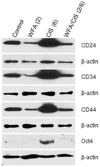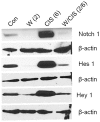Withaferin a alone and in combination with cisplatin suppresses growth and metastasis of ovarian cancer by targeting putative cancer stem cells
- PMID: 25264898
- PMCID: PMC4180068
- DOI: 10.1371/journal.pone.0107596
Withaferin a alone and in combination with cisplatin suppresses growth and metastasis of ovarian cancer by targeting putative cancer stem cells
Abstract
Currently, the treatment for ovarian cancer entails cytoreductive surgery followed by chemotherapy, mainly, carboplatin combined with paclitaxel. Although this regimen is initially effective in a high percentage of cases, unfortunately within few months of initial treatment, tumor relapse occurs because of platinum-resistance. This is attributed to chemo-resistance of cancer stem cells (CSCs). Herein we show for the first time that withaferin A (WFA), a bioactive compound isolated from the plant Withania somnifera, when used alone or in combination with cisplatin (CIS) targets putative CSCs. Treatment of nude mice bearing orthotopic ovarian tumors generated by injecting human ovarian epithelial cancer cell line (A2780) with WFA and cisplatin (WFA) alone or in combination resulted in a 70 to 80% reduction in tumor growth and complete inhibition of metastasis to other organs compared to untreated controls. Histochemical and Western blot analysis of the tumors revealed that inclusion of WFA (2 mg/kg) resulted in a highly significant elimination of cells expressing CSC markers - CD44, CD24, CD34, CD117 and Oct4 and downregulation of Notch1, Hes1 and Hey1 genes. In contrast treatment of mice with CIS alone (6 mg/kg) had opposite effect on those cells. Increase in cells expressing CSC markers and Notch1 signaling pathway in tumors exposed to CIS may explain recurrence of cancer in patients treated with carboplatin and paclitaxel. Since, WFA alone or in combination with CIS eliminates putative CSCs, we conclude that WFA in combination with CIS may present more efficacious therapy for ovarian cancer.
Conflict of interest statement
Figures








References
-
- Siegel R, Naishadham D, Jemal A (2013) Cancer statistics. CA Cancer J Clin 63: 11–30. - PubMed
-
- Hunn J, Rodriguez GC (2012) Ovarian cancer: etiology, risk factors, and epidemiology. Clin Obstet Gynecol 55: 3–24. - PubMed
-
- National Comprehensive Cancer Network. NCCN Clinical Practice Guidelines in Oncology. Ovarian Cancer. Version 1.2013. Available: HTTP://www.nccn.org/professionals/physician_gls/pdf/ovarian.pdf
-
- Piccart MJ, Bertelsen K, Stuart G, Cassidy J, Mangioni C, et al. (2003) Long- term follow-up confirms a survival advantage of the paclitaxel-cisplatin regimen over the cyclophosphamide-cisplatin combination in advanced ovarian cancer. Int J Gynecol Cancer 13 Suppl 2: 144–148. - PubMed
Publication types
MeSH terms
Substances
Grants and funding
LinkOut - more resources
Full Text Sources
Other Literature Sources
Medical
Miscellaneous

